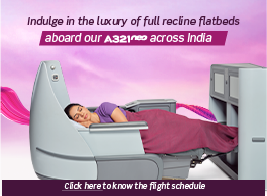These cookies are necessary for the operation of the website. We only collect the minimum information needed to provide services on airvistara.com
Special Assistance
We believe that every customer is special. At Vistara, we ensure you travel without any worry and are here to assist you at every step.
When assessing a patient's fitness for air travel, the effects of typical aviation factors are to be considered. Although each case will be considered on its merit, the detailed guidelines are laid down for treating physician’s and customer’s reference. These are mere guidelines and cannot be considered as company policy. For detailed description, please refer to the ‘Medical Clearance Guidelines for Air Travel’ document available here. Some typical conditions are described below:
Epilepsy
Psychiatric Conditions
Cognitive and Developmental conditions (e.g., Autism etc)
Travellers' thrombosis (DVT)
Diabetes
Food Allergies
Spinal Support Equipment (SSE)
Internal Medical Devices, Pacemakers, DBS setup and Implanted Metal Items/Devices for Orthopaedic Use (like artificial joint replacement, metal wires/nails for fracture treatment etc.)
Stretcher case travel/requirement on board
Medical oxygen (onboard oxygen)
‘Portable Oxygen Concentrator’ (POC), Other ‘Portable Medical Electronic Devices’ (MPED) and ‘Respiratory Assistive devices’
Personal oxygen cylinders and cans
Medications and needles
Needles and syringes
Refrigeration of medication inflight
Advice to Customers for Carriage of Medications
MEDA CLEARANCE (MEDICAL CLEARANCE TO FLY)
Customers with conditions that are likely to deteriorate during a flight or may aggravate and pose a safety/security risk to self/others require special clearance as per standard aviation regulations.
For medical clearance, customers are required to fill a MEDIF form as per detailed instructions mentioned therein and submit the same to medical.clearance@airvistara.com.
Any decision of the TSAL medical team related to additional medical assistance, type of escort required (as and if applicable) will be final.
MEDA clearance timeline:
Minimum time for MEDA clearance (including stretcher case approval/handling) application is 48 hours before the date of travel; from the time MEDIF form complete in all aspects is received. In case incompletely filled form is received, then 48 hours will be from the time complete MEDIF form is received. We recommend that you plan your travel with due consideration to minimum time required for MEDA clearance.
Maximum duration before the date of travel when such application can be made is 10 days.
MEDA Clearance to fly is generally required in the following scenarios:
- Customer suffers from any disease, which is believed to be actively contagious and communicable.
- Customer, because of certain diseases, or incapacitation may have or develop an adverse physical condition which could have an adverse effect during flight and on safety and emergency evacuation procedures like a customer’s fitness to travel is in doubt as a result of recent illness, hospitalization, injury or surgery and there is reasonable doubt that they can complete the flight safely without requiring extraordinary medical assistance during the flight e.g. breathing difficulties, unstable angina, terminal illness etc.
- Customer would require medical attention and/or special equipment to maintain their health during the flight.
- MEDA Clearance is required for customers who:
- Would be travelling in a stretcher on-board or with an incubator
- Needs medical oxygen during the flight
- Complicated (single/multiple) pregnancy cases between 29-32 weeks
- In case of an infant if new-born suffers from serious illness which may be covered in abovementioned points.
Scenarios in which case MEDIF (Medical Information) Form (Prior MEDA Clearance) is not required
- Guests requesting for wheelchair due to old age, arthritis, post-poliomyelitis, muscle weakness condition, locomotor disability or joint sprain etc. in the absence of any other significant medical condition or illness.
- Hearing, speech and visual disabilities and difficulties.
- Guests with chronic, stable, controlled disorders like Diabetes Mellitus, Thyroid conditions Hypertension etc.
- FAA approved Portable Oxygen Concentrator (POC) and Respiratory Assist Devices (like BiPAP, CPAP etc for sleep apnoea and other conditions) provided the medical conditions it is used for, are stable and there has been no recent hospital admission, deterioration etc in the same.
Instructions for completing MEDIF Form
For medical clearance, MEDIF form will need to be filled and submitted as per instructions mentioned. However, some salient points are as follows:
- Part 1 of MEDIF form: To be filled by trade partner or customer themselves. All travel details are to be completely and compulsorily filled. Declaration in Part 1 is also compulsory and should be signed by customer or his/her relative/representative. Without this declaration, MEDA clearance request cannot be processed.
- Part 2 and 3 of MEDIF form: To be filled and signed with stamp of doctor (minimum MBBS or equivalent qualification in modern medicine/allopathy doctor’s signature and stamp only will be accepted). All columns to be filled. If any column is not relevant, please mention ‘Not Applicable’ therein.
- The MEDIF form which will be submitted by the customer needs to be complete in all aspects. Incomplete or casually filled MEDIF forms may cause delay in processing medical clearance. Minimum MEDA clearance timeline will be followed from the time MEDIF form complete in all aspects is received. Incompletely filled form will mean delay in processing.
Cautionary Note:
- Cabin attendants are not authorized to give special sanitary assistance to any particular customer, to the detriment of their services to other customers as they are authorized food handlers. Additionally, they are trained only in providing basic first aid and are not permitted to administer any injections, give medication from medical kit or advanced medical treatment/procedures.
- As a safety regulatory requirement, feet/lower limbs should not be extended towards the aisle or on adjoining seat/seats. If it is not possible, then the customer must opt for a stretcher.
- Customer should be able to travel while utilizing normal aircraft seat with seat back upright and knees bent. If it is not possible due to any reason, then the customer must be required to opt for a stretcher.
- Do note in rare case if medical condition of the customer suddenly/unpredictably deteriorates at the time of boarding (despite obtaining MEDA clearance in advance) then boarding may be denied and will cause offloading of the customer for further assessment and treatment at airport medical centre, in the interest of health and safety of the customer. Boarding may also be denied in case it becomes apparent that customer cannot be seated in the normal upright and knees bent position (due to any reason). Prior MEDA clearance does not guarantee carriage if the condition of the guest has deteriorated after clearance has been obtained. It will be the responsibility of the customer or their representatives to inform the airline, in case of change or deterioration of medical condition after obtaining MEDA clearance.
 Top
Top



























 Book
Book

 Check-in
Check-in

 Deals and Offers
Deals and Offers

 Flight Schedule
Flight Schedule












